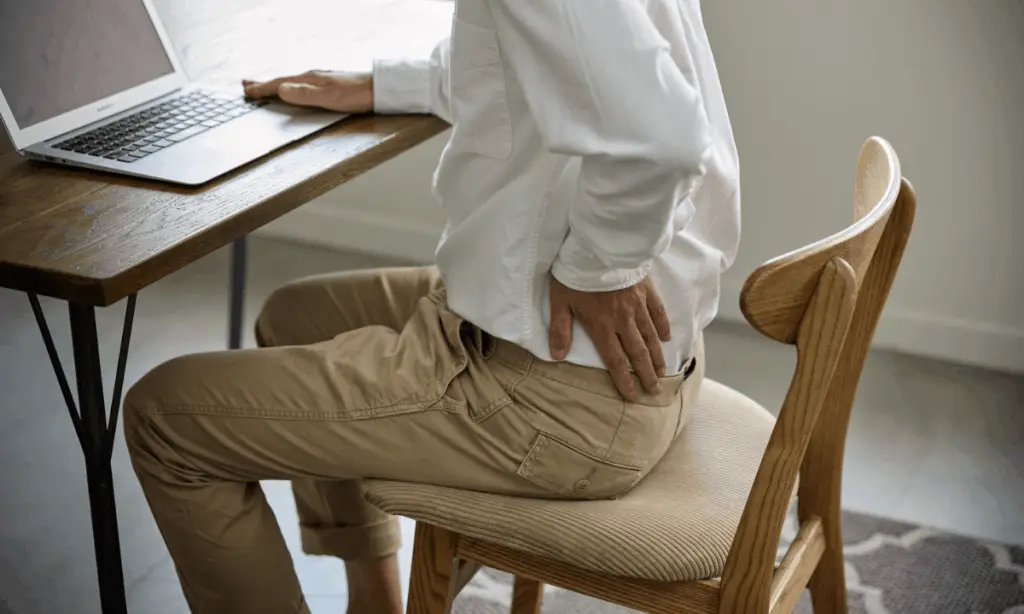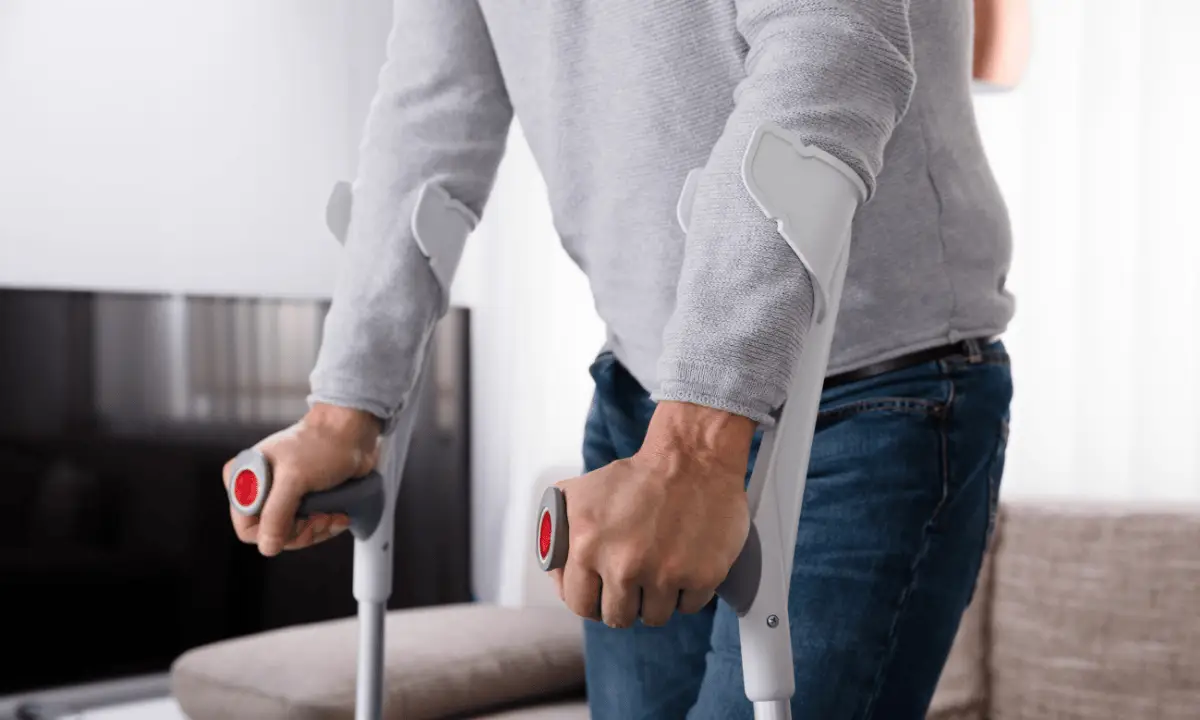If you’re dealing with bursitis caused by your work duties, you’re not alone. Many Australian workers experience repetitive strain injuries that slowly develop into painful conditions like bursitis. Making a bursitis compensation claim can feel overwhelming, especially when you’re trying to focus on your recovery. That’s where experienced bursitis lawyers can step in to guide you through the legal process with confidence.
At Withstand Lawyers, we understand the physical, emotional and financial toll that a work-related bursitis injury can have on your life. Whether you’re just starting to notice symptoms or have already been diagnosed, it’s important to understand your rights and the workers compensation benefits you may be entitled to.
Read on to find out how our experienced workers compensation lawyers can help you claim compensation for bursitis from work on a No Win, No Fee basis.

What Is Bursitis and How Does It Occur at Work?
Bursitis is the inflammation of the small fluid-filled sacs called bursae that cushion the bones, tendons and muscles near your joints. When these sacs become irritated, they can cause significant pain, swelling and restricted movement. While bursitis can develop from sudden injury, it most commonly results from repetitive motion or prolonged pressure on a joint over time.
Common symptoms of bursitis include joint pain, stiffness, swelling and reduced range of motion, most commonly in the shoulders, elbows, hips and knees. Bursitis may start off mildly but can become chronic and debilitating without early intervention.
If your bursitis has developed because of your job or has been aggravated by your work duties, you may be eligible to make a bursitis compensation claim under the Workers Compensation Scheme in NSW.
Understanding how bursitis occurs and where it most commonly arises at work is the first step towards protecting your health and recognising your legal entitlements.
Common Work Activities That Lead to Bursitis
Bursitis is often the result of preventable or repetitive work-related tasks. Some of the most common workplace activities that cause or aggravate bursitis include:
Repetitive Lifting and Reaching: Constant overhead lifting or reaching can lead to shoulder bursitis, particularly in warehousing, construction and care work.
Frequent Kneeling or Crawling: Jobs involving prolonged kneeling, like floor tiling, plumbing or cleaning, can cause knee bursitis (prepatellar bursitis).
Heavy Manual Labour: Regular use of tools or machinery that put strain on joints can inflame the bursae in the elbows and wrists.
Prolonged Pressure on Joints: Tasks that involve leaning on hard surfaces or remaining in one position for long periods can gradually lead to inflammation.
Desk-Based Work: Even stationary office jobs can contribute to repetitive strain injuries. Workers can experience bursitis if poor posture or repetitive mouse and keyboard use leads to joint stress over time.
Which Body Parts Are Most Commonly Affected by Bursitis?
Bursitis can affect several joints in the body, particularly those exposed to repetitive motion, prolonged pressure, or awkward postures at work. The severity of a bursitis compensation claim often depends on which joint is involved, how much it limits your mobility, and whether it leads to long-term functional impairment.
Here are the most commonly affected areas that we see workers experience bursitis:
One of the most common sites for work-related bursitis. Repetitive overhead work, lifting or awkward arm movements can inflame the shoulder bursae, leading to pain and restricted movement.
Click here to learn more about shoulder injury compensation claims.
Kneeling for extended periods, especially on hard surfaces, can cause prepatellar or infrapatellar bursitis. Common in construction, plumbing, and cleaning roles.
Discover your rights after a knee injury at work.
Leaning on hard surfaces or repetitive tasks involving pressure on the elbows can lead to olecranon bursitis, also known as student’s elbow.
Read more about how we can help with elbow injury claims.
Hip bursitis can be caused by prolonged standing, lifting, or twisting motions. It often affects workers in aged care, retail, logistics, and manual labour.
Find out how we assist with hip injury workers compensation claims.
Though less common, wrist bursitis can develop from repetitive strain such as typing, lifting or assembly line tasks, especially if ergonomics are poor.
Learn more about making a compensation claim for wrist injuries at work

What Compensation is Available for Bursitis?
If you’ve developed bursitis due to your job or had an existing condition aggravated by work duties, you may be entitled to workers compensation in NSW.
Your eligibility and the extent of your entitlements depend on how severe your bursitis is, how it impacts your ability to work, and whether it leads to a permanent impairment. Understanding your rights can help ensure you receive the full bursitis compensation you’re entitled to.
Workers Compensation Benefits for Bursitis
Under the NSW workers compensation scheme, you may be eligible to receive:
✅ Income Support: Weekly payments based on a percentage of your pre-injury wages if you are unable to work or are working reduced hours. Payments can be up to 95% of your pre-injury average weekly wages.
✅ Medical Treatment Expenses: Covering doctor visits, physiotherapy, medications, imaging, joint injections, and any necessary surgery.
✅ Travel Expenses: Reimbursement for travel costs related to medical appointments and treatment.
✅ Return-to-Work Services: Support with rehabilitation, retraining, and workplace adjustments to help you get back to work safely.
These benefits are designed to reduce financial stress and support your recovery while you manage your bursitis injury.
Lump Sum Payments for Permanent Impairment
If your bursitis has become a chronic or long-term condition that causes lasting disability, you may also be entitled to a lump sum compensation payment under the NSW workers compensation system. This payment applies if your injury is assessed as causing permanent impairment.
Whole Person Impairment (WPI) Requirements
To qualify for a lump sum payment, your bursitis injury must be medically assessed by an approved Independent Medical Examiner (IME) who will assign a Whole Person Impairment (WPI) rating. This rating reflects how your injury affects your overall function on a long-term basis.
For physical injuries, such as permanent joint damage in the knees or shoulders, a WPI of at least 11% is required to be eligible for a lump sum payout.
For psychological injuries related to chronic pain or stress as a result of your bursitis (such as anxiety disorders or depression from prolonged suffering), the WPI threshold is 15% or higher.
Eligibility Requirements for a Bursitis Lump Sum Payment
To be eligible for a permanent impairment lump sum, you must meet the following criteria:
Your bursitis injury is work-related and accepted under the NSW workers compensation scheme.
You have limited range of movement in your shoulder due to shoulder pain.
- The condition has stabilised (usually after 6 months) and has been assessed as causing permanent impairment by your doctor or specialist.
Not sure if your bursitis qualifies? Our team can help you arrange the WPI assessment, guide you through what to expect, and manage your entire claim process to maximise your entitlements.
Contact us today for a free claim assessment and let us help you secure the entitlements you deserve after suffering from bursitis at work.

How to Make a Bursitis Compensation Claim in NSW
If you have bursitis that was caused or aggravated by your work, it’s essential to take the right steps early to protect your health and your legal rights.
Lodging a successful bursitis compensation claim in NSW involves the following important steps:
If you’ve developed bursitis due to your job, one of the most important first steps is to see your GP. Getting medical attention early not only helps manage your condition but also plays an important role in the success of your workers compensation claim.
Here’s how your GP can support both your treatment and legal process:
Diagnose Your Condition
Your doctor will assess location and severity of your bursitis. They’ll evaluate your symptoms, such as pain, swelling, or restricted movement, and may order imaging (like ultrasound or MRI) to confirm the diagnosis. This medical evidence is necessary for a successful bursitis compensation claim.
Link Your Bursitis to Work Duties
To support your claim, your GP needs to clearly document how your work duties caused or aggravated your bursitis. This might include repetitive lifting, prolonged kneeling, poor ergonomics, or pressure on joints. Establishing a strong connection between your job and your bursitis condition is key to having your claim accepted.
Obtain a Work Capacity Certificate
Your GP will also provide a Work Capacity Certificate that outlines your diagnosis, treatment plan, physical restrictions and whether you can continue working. This certificate is required when submitting a bursitis compensation claim through the NSW workers compensation scheme.
You must notify your employer about your bursitis injury as soon as possible. Whether the condition developed gradually or was aggravated by your work duties, prompt and accurate reporting ensures your employer can notify their workers compensation insurer (so you can begin to receive your benefits)
Delays in reporting may affect your entitlements or result in complications or disputes during the claims process.
After notifying your employer about your bursitis injury, the next step is to submit your claim to their workers compensation insurer. To strengthen your claim and avoid unnecessary delays, it’s important to include all required documentation:
1 – Completed Workers Injury Claim Form:
The Workers Injury Claim Form explains how your bursitis developed or was aggravated by your work duties. Be as specific and accurate as possible, especially when describing your work tasks and how they contributed to your condition.
2 – Work Capacity Certificate and Medical Reports:
Attach the Work Capacity Certificate from your GP, along with any medical documentation, imaging results (such as ultrasound or MRI), or specialist reports. These records should detail the diagnosis of your bursitis, its severity, the treatment plan, and how it impacts your ability to perform your job.
3 – Relevant Workplace Evidence:
Include any incident reports, ergonomic assessments, supervisor notes, photos of your workstation or working environment, and witness statements that support your claim. This evidence can help establish a clear link between your bursitis and your work duties or conditions.
By submitting these materials to the insurer, you take a key step toward securing your bursitis injury compensation. Complete and well-supported documentation significantly improves your chances of approval and maximises your potential payout.
Not sure where to start? Chat with our workers compensation lawyers today to find out how we can lodge the claim on your behalf. Our fees are covered by the Independent Review Office (IRO) so you won’t pay to make a workers compensation claim. Contact us today for a free claim assessment.
Once you’ve submitted your claim, the insurer will assess it to decide whether to approve or deny your request for compensation. During this process, they may reach out to your healthcare providers, employer, or other relevant parties to gather additional information about your condition and its link to your workplace.
If the insurer approves your claim, you’ll start receiving workers’ compensation entitlements, which may include:
- Weekly Payments: Up to 95% of your average weekly earnings
- Medical Expense Coverage: for treatments, medications, and therapies related to your bursitis.
- Rehabilitation Services: assistance with recovery or transitioning to a different role if needed.
If your claim is denied, you still have options. Contact our workers compensation lawyers today to find out how we can help you take the next steps towards fair compensation for your bursitis from work.
Common Law Compensation for Bursitis Caused by Workplace Negligence
If your bursitis injury was caused or aggravated by your employer’s negligence, you may be entitled to make a common law damages claim. This type of claim, also known as a work injury damages claim, allows you to claim a payout for past and future economic loss that exceeds the benefits available under standard workers compensation claims.
What Is a Common Law Claim?
A common law claim is legal action taken against a party (usually your employer) when their negligence or failure to provide a safe work environment contributed to your injury. Unlike statutory workers compensation, which is a no-fault system, a common law claim requires you to prove that your bursitis was caused or aggravated due to a breach of duty of care.
Examples of employer negligence that may lead to a bursitis injury include:
Failure to provide ergonomic equipment or workstations
Requiring repetitive or physically demanding tasks without breaks or rotation
Ignoring reports of joint pain, swelling or early injury symptoms
Lack of appropriate manual handling training
Unsafe working conditions, such as hard surfaces for prolonged kneeling or overhead lifting without support
What Can You Claim?
Common law damages for work-related bursitis can include:
✅ Past economic loss: Income you’ve lost due to being unable to work from the date of injury until now
✅ Future economic loss: Projected loss of income if you are unable to return to your previous role or capacity
✅ Loss of superannuation: Compensation for missed superannuation contributions related to your lost earnings
Unlike regular workers compensation payments, common law damages are not capped and may result in a significantly larger payout. It’s important to note however that once a common law claim is settled, you will no longer be entitled to ongoing workers compensation payments. That’s why making this type of claim requires careful legal guidance.
Contact our team of work injury damages lawyers today for a free claim assessment to ensure you are receiving the maximum compensation available.
Eligibility Requirements
To make a successful work injury damages claim for bursitis in NSW, you must meet these legal requirements:
Be assessed as having a Whole Person Impairment (WPI) of at least 15%
Prove that your bursitis was caused or significantly worsened by negligence
Proving negligence isn’t always simple, especially in cases where the injury develops gradually over time. At Withstand Lawyers, we have extensive experience holding employers accountable for unsafe work conditions that contribute to chronic joint injuries like bursitis. Contact us today to see how we can help you claim your entitlements on a No Win No Fee basis.

Making a TPD Claim for Bursitis
rIf your bursitis injury has left you unable to return to work, you may be eligible to make a Total and Permanent Disability (TPD) claim through your superannuation fund. A TPD claim is separate from your workers compensation entitlements and can provide a significant lump sum payout to support your long-term financial security.
What Is a TPD Claim for Bursitis?
A TPD claim is an insurance benefit attached to most superannuation policies. It provides a lump sum payout if you are unable to return to work due to an injury, illness or condition. It does not need to be a work related injury and it does not require anyone to be at fault. Many workers are unaware they have TPD cover, but most super funds include it by default.
In cases where bursitis becomes chronic, causing long-term damage, and prevents you from performing a job that matches your education, training or experience, then a TPD payout may be available.
Am I Eligible to Make a TPD Claim After a Bursitis Injury?
To qualify for a TPD payout following a work-related bursitis injury, you generally need to meet the following conditions:
You were contributing to a superannuation fund that includes TPD insurance at the time your bursitis injury prevented you from working
You are unable to return to your regular job or any role for which you are reasonably qualified by education, training, or experience
Each superannuation fund defines “total and permanent disability” slightly differently however, so it’s important to carefully review your policy before applying.
Not sure if you have TPD cover or meet the eligibility criteria outlined in your policy? Our experienced TPD lawyers can assess your situation, confirm your eligibility with your current policy, and manage your claim on a No Win No Fee basis. Contact us today to get started with our free claim assessment.
What Evidence Do You Need for a Bursitis TPD Claim?
To support a successful TPD claim for bursitis, you will usually need:
Medical reports and specialist assessments confirming the diagnosis and severity
Functional capacity evaluations showing your limitations at work
Statements from your employer about your job duties and any restrictions
Copies of your superannuation policy and insurance documents
Proof of identity, work history and earnings
Can You Claim Both TPD and Workers Compensation for Bursitis?
Yes, you can claim both TPD and Workers Compensation at the same time. TPD claims are separate from Workers Compensation claims, and one does not affect the other. TPD payouts can provide significant financial support alongside your workers compensation benefits, ranging anywhere from $50,000 to over $350,000, depending on your TPD policy.
At Withstand Lawyers, we help injured workers navigate both systems to maximise their entitlements. We’ll handle the paperwork, deal with your super fund and insurer, and ensure your TPD claim is as strong as possible, all on a No Win No Fee basis. Contact us today for a free claim assessment.

Let Withstand Lawyers Help You Claim Bursitis Compensation
Navigating the NSW workers compensation system can be overwhelming, especially when you’re dealing with the physical pain, emotional stress, and financial impact of a serious bursitis injury caused or aggravated by your job. That’s where Withstand Lawyers can support you.
Our team understands the complexities of bursitis compensation claims and the barriers injured workers often face when dealing with insurers, employers, and medical recovery. Here’s how we help:
✅ Decades of experience handling workers compensation claims, including chronic and complex bursitis cases across NSW
✅ Clear guidance at every stage, from initial claim lodgement to insurer disputes, appeals, and settlements
✅ Maximising your entitlements, including weekly income support, medical treatment costs, rehabilitation services, and permanent impairment payments
✅ No Win, No Fee cost agreement, meaning you pay nothing unless you win.
At Withstand Lawyers, we’ve helped thousands of injured workers across NSW secure the compensation they deserve. If your bursitis injury is impacting your ability to work, we’re here to help.
Call us today on 1800 952 898 or fill out our online form for a free claim assessment so you know exactly where you stand.

Issa Rabaya
• Bachelor of Laws
• Graduate Diploma in Legal Practice
• Approved Legal Service Provider to the Independent Review Office
• Member of the Law Society

Issa Rabaya
• Bachelor of Laws
• Graduate Diploma in Legal Practice
• Approved Legal Service Provider to the Independent Review Office
• Member of the Law Society
Bursitis Compensation Claim FAQs
In the workplace, bursitis is commonly caused or aggravated by repetitive motion, sustained pressure on joints, manual handling, or poor ergonomics. Over time, these tasks can lead to chronic pain, swelling, and limited mobility in areas like the shoulders, knees, elbows, or hips.
Yes. If your bursitis injury developed from work duties or was worsened by your job, you may be eligible to claim workers compensation in NSW. This includes medical treatment, income support, and potentially a lump sum for permanent impairment.
Yes, if your bursitis results in permanent impairment, you may be entitled to a lump sum compensation payment under NSW workers compensation law. A Whole Person Impairment (WPI) assessment will determine your eligibility. Our team can help you arrange an assessment. Contact us today to see how we can help.
In NSW, workers compensation claims generally must be lodged within six months of the injury or diagnosis.
Depending on your situation, you may still be eligible to make a claim beyond this time limit however. Contact our team today for a free claim assessment to know where you stand.
Yes. TPD claims are separate to workers compensation, and one does not affect the other. Many clients who claim workers compensation are also eligible to make a TPD claim if they can no longer work in a job they have training or experience in.
If your workers compensation claim is rejected, you may have the right to challenge the decision.
Our workers’ compensation lawyers can assist you with an appeal. Contact us today for a free claim assessment.
No Win, No Fee means you don’t pay any legal fees unless your case is successful. This means you can access legal help for your bursitis compensation claim without any upfront costs.
And for workers compensation claims, our fees are covered by the Independent Review Office (IRO), so you won’t have our fees deducted from your settlement.
You may still be eligible for compensation if your job aggravated a pre-existing bursitis condition. NSW workers compensation law recognises aggravation, acceleration, or deterioration of existing injuries as valid grounds for a claim.




